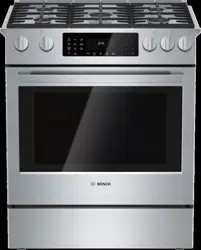Documents: Go to download!
- Owner's manual - (English, French)
- Getting Started
- Operation - Oven
- Operation
- Getting the Most Out of Your Oven
- Cooking Modes
- Cleaning and Maintenance
- Self Help
Table of contents
User manual Range
Getting Started
Parts and Accessories
Your appliance may vary slightly.
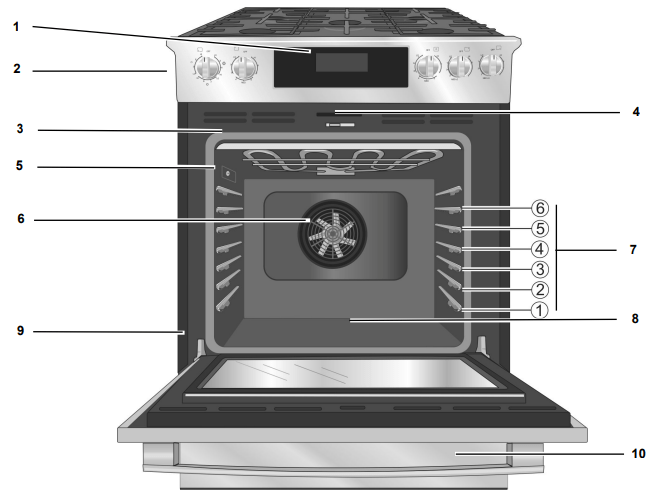
Range Parts Key
1 Oven Control Panel
2 Cooktop Control Knobs
3 Door Gasket
4 Door Latch
5 Probe Jack
6 Convection Fan
7 Rack Position Guides with 6 rack positions
8 Oven Bottom
9 Door Hinge
10 Warming Drawer
Operation - Oven
Oven Control Panel

800 Series Oven Control Panel
1 Mode Selection Touchpads
2 Display
3 Numeric Keypad Touchpads
4 Special Function Touchpads
Touchpads
Note: You only need to press lightly on the touchpads to operate them.
Touchpad Descriptions
Panel Lock ( hold 3 sec) | Turns Panel Lock mode on and off. |
| Oven Light | Turns the oven lights on or off. |
Kitchen Timer ( on/off) | Starts and stops the kitchen timer(s). Press to edit a timer. |
| Oven Timer | Press to edit the oven timer for the selected oven. Turns off the oven at the end of the specified time. |
| Setting | Provides access to user settings to allow customization of basic display, language and other features. Use also to set the clock. |
| Probe | Sets probe target temperature. Probe allows monitoring of internal meat temperatures during cooking. |
| Fast Preheat | Enables Fast Preheat option. |
| Self Clean | Activates Self Clean mode. |
| More Modes | Allows access to cooking/heating modes that do not have a direct access touchpad. |
Warning Drawer ( on/off) | Turns the warming drawer on or off. |
Operation
About the Appliance
Your new oven combines premium cooking results and simple operation.
The oven design has been optimized to improve heat distribution in the oven cavity. The result is even browning, shorter cooking times and lower energy consumption.
Thanks to the Self-Clean mode, hours of scrubbing into the darkest corners of the oven is a thing of the past. The oven burns off soil simply and easily. All that is left to do is to remove a few ashes from the oven when Self-Clean is done.
Clear labeling of the touch pads makes operating the oven very easy. This manual includes all instructions for operating the oven.
Please call us if you ever have any questions. Our telephone number is located at the beginning of this manual. We welcome your comments and suggestions!
Basic Features
Setting the Clock
The oven includes time functions that require the current time to be set. It is therefore important to set the clock before beginning to use the oven. The oven cannot be in a cooking mode to access the clock set mode.
To set the clock:
- The oven must be in Stand-By mode (oven is powered on, but no cooking mode or timer in operation).
- To access the clock set mode: Press the Settings touchpad. The display shows “SET CLOCK”. Press Enter to edit the clock.
- Use the numeric keypad to enter the desired time. Each number pressed is entered at the right and moving previously entered digits to the left. To set “12:45 pm”, press 1, 2, 4, 5.
- When the desired time is entered, set the time by pressing Enter. The clock is now set and running.
Setting the Cooking Mode and Temperature
There are two alternate methods to set cooking mode and temperature.
To set the Cooking Mode first, then the temperature:
1. Press the desired Cooking Mode Touchpad. The cooking mode and default temperature are displayed. The temperature flashes to show it can be edited.
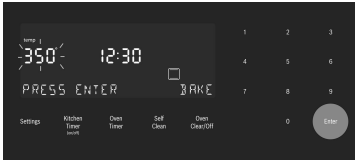
2. Press Enter to start the mode using the default temperature.
3. To change the temperature, enter the new temperature using the numeric touchpads. 375° is used for this example. Press Enter to set the updated temperature. Note: The new temperature is automatically set after 10 seconds if Enter is not pressed.
4. Preheating starts.
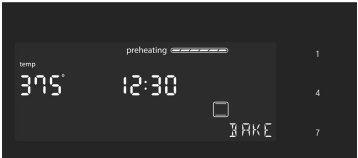
Note: If a temperature is entered that is not within the allowed range for the mode, an error tone will sound and the lower part of the screen will display “TEMP NOT ALLOWED”.
To set the Temperature first and then the Cooking
Mode: (not for Broil or Convection Broil)
1. Press the numeric keys to enter the desired temperature setting. The temperature entered is displayed beside the current time.
2. Select a cooking mode that is compatible with the temperature entered. If no cooking mode is selected within 5 seconds of setting the temperature, an error tone sounds and a SELECT MODE message is displayed and blinks.
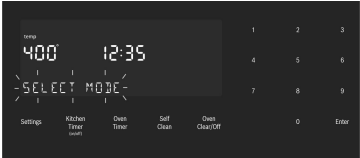
3. Press a Mode Selection Touchpad to select a cooking mode.
The new mode and temperature set automatically after 10 seconds if Enter is not pressed.

Note: If a temperature is entered that is not within the allowed range for the mode selected, an error tone will sound and the lower part of the screen will display “TEMP NOT ALLOWED”.
To change the Oven Temperature
1. Press the Cooking Mode Touchpad.
2. The current temperature flashes. Use the numeric touchpads to enter a new temperature. Press Enter.
Heating Time Limitation
The maximum heating time is limited. If you forget to turn off the oven, it turns off automatically after a set period of time.
The maximum time for Sabbath mode is 74 hours; for all other cooking modes the maximum allowed time is 24 hours.

Timer
Your new oven is equipped with two types of timers.
Kitchen Timer - is a countdown timer that has no affect on oven heating. The kitchen timer is used for general kitchen timing needs.
Oven Timer - is a countdown timer which upon reaching 00:00 turns the oven off, stopping the current mode. The oven timer is used to set how long a mode will run (not available for Broil, Convection Broil).
To set a kitchen timer:
(for general kitchen timer needs)
1. Press the Kitchen Timer On/Off. 0:00 is displayed and blinks in the display. Enter the desired timer value in H/MM format using the numeric touchpads.
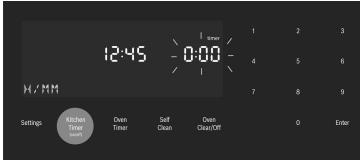
2. Press Enter. The kitchen timer starts.
3. When the kitchen timer has counted down to zero an alarm tone sounds every 10 seconds for 2 minutes and the message “TIMER END” is displayed.
Cancel the kitchen timer - by pressing the Kitchen Timer On/Off button.
Note The timer does not change when other settings are changed.
To edit an kitchen timer:
1. Press the Kitchen Timer On/Off button.
2. The current time value blinks and can be edited.
To set an oven timer:
(for setting a timer to turn the oven off)
Note: An oven timer cannot be run during Self Clean.
1. Press the Oven Timer touchpad.
2. Select mode, press Enter. 0:00 is displayed and blinks in the display. Enter the desired timer value in H/MM format using the numeric keypad.
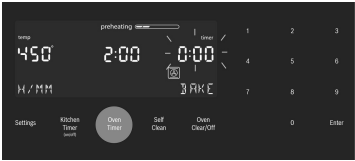
Press the Enter touchpad. The oven timer counts down to 0:00.
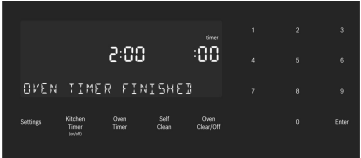
3. When the timer reaches :00 the cooking mode ends and the message “OVEN TIMER FINISHED” is displayed. The oven alarm tone sounds every 10 seconds for 2 minutes.
Editing the oven timer
1. If the oven timer is running and the time remaining needs to be changed, enter the oven timer mode by pressing the Oven Timer touchpad.
2. The temperature blinks, indicating it can be edited. Input a new temperature or press Enter for no change.
3. The timer value blinks, indicating it can be edited. Input the new time and restart the timer by pressing the Enter touchpad.
The oven timer may be cleared by entering 0:00.
Fast Preheat
Fast Preheat heats the oven quicker than standard preheat. It is available for Bake, Convection Multi Rack, Convection Bake, Convection Roast, Roast, and Pizza (Roast is found in the “More Modes” menu). If Fast Preheat is not allowed for the selected cooking mode an error tone sounds. Fast Preheat is not available for Broil, Convection Broil, Proof or Warm.
To set Fast Preheat:
1. Press Fast Preheat. The fast preheat icon  appears in the display just above the mode name.
appears in the display just above the mode name.
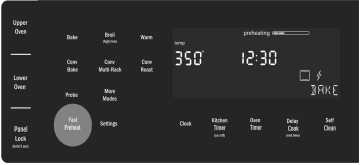
2. Press Start.
Fast Preheat can be turned off by pressing Fast Preheat again.
Special Features
The special features provide you with additional conveniences when cooking.
Learn more about these special features in the following sections:
- Probe
- Sabbath Mode
- Panel Lock
Probe
The probe measures the internal temperature of the food. The probe is available for Bake, Roast and all convection cooking modes except Convection Broil.
Remove Safety Cap before Using Probe
Some models include a temperature probe used to sense internal tempererature of meats during cooking.
The probe ships with a black plastic safety cap over the pointed metal end of the probe. The cap must be removed prior to use.

Inserting the probe:
Insert the tip of the probe in the middle and thickest part of the meat or breast for poultry. Make sure the probe is not touching fat, bone, or parts of the oven or the pan.
Note: Food must be completely thawed before inserting the probe into the meat.
To use the probe:
- Insert the probe into the meat as described above. The probe symbol is displayed.
- Connect the probe to the oven. If the probe is not connected to the oven prior to starting Probe mode, an error tone sounds and the message “INSERT PROBE” is displayed.
- Set the cooking mode and temperature.
- The Set Probe Temp screen is displayed. A three digit input prompt “- - -” blinks in the lower right corner. Use the numeric keypad to enter the desired probe temperature and press Enter on the numeric keypad.
Note: The minimum probe temperature that can be set is 100° F (40° C) and the maximum is 200° F (100° C). If the probe temperature entered is outside this range, an error is displayed.

5. The probe current temperature and target temperature are both displayed in the format “105 / 180” at the lower right corner of the display. The actual temperature will display < 80 until the food temperature reaches 80³ F. The displayed probe temperature is updated in increments of 5° during the cooking process.
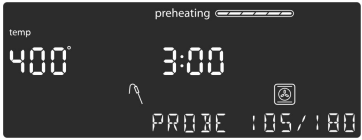
6. When the probe temperature reaches the set temperature, the cooking mode turns off. The current time is displayed and the message “COOKING COMPLETE” blinks at the bottom left of the display. An alarm tone sounds every 10 seconds for 2 minutes.
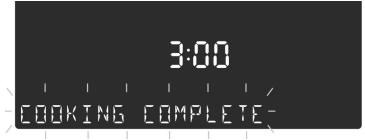
This screen remains in the display until it is cleared by pressing the Oven Clear/Off touchpad or until the probe is removed. The display then goes back to stand by mode.
Note:
- Probe is not available when an Oven Timer has been set.
- To change the probe temperature press the Probe touchpad. The display enters probe temperature editing mode and displays the message “SET PROBE TEMP”. Enter the new probe temperature and press Enter to accept the new value.
- Do not store the probe in the oven.
- Always use the handle of the probe for inserting and removing.
- Always use a potholder to remove the probe since it becomes hot.
- Since meat continues to cook after being removed from the oven, set the internal (probe) temperature 5 - 10 degrees below the desired final internal temperature (exception poultry).
Sabbath Mode
The Sabbath mode enables those of particular faiths to use their ovens on the Sabbath.
The Sabbath mode can be entered in a Bake mode only. The bake temperature must be within the Sabbath mode temperature range of 100° to 450° F.
If the oven light is on during setup, it remains on throughout the Sabbath mode operation. If the oven light is off during setup, it remains off throughout the Sabbath mode operation.
To set the Sabbath Mode:
No kitchen timers or oven timers may be running when Sabbath mode is entered.
1. Begin a Bake operation. While Bake is running, press and hold the Oven Timer touchpad for five seconds. If a timer is running when Sabbath mode attempts to start, the display blinks the message: “SABBATH NOT AVAILABLE”.
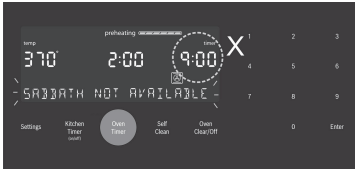
If no timers are running, the Sabbath mode settings appear in the display. The Sabbath Mode timer blinks showing the value can be edited. The default value is 74:00 (the maximum number of hours for which Sabbath Mode can be set.)

2. Press Enter to accept the default 74:00 hours and start Sabbath Mode. Or use the numeric keypad to enter the desired Sabbath mode timer value. Timer values between 0:01 and 74:00 can be entered. Note: If no changes are made within 10 seconds, Sabbath Mode auto starts.
3. Once Sabbath mode has begun, the display changes to show the message “SABBATH ON”.
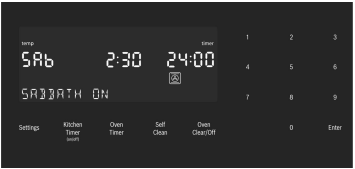
4. After the Sabbath mode countdown reaches zero, the oven displays the current time and the message “SABBATH”. No changes can be made at this point. To end the Sabbath Mode and return to normal function, press the Oven Clear/Off touchpad.
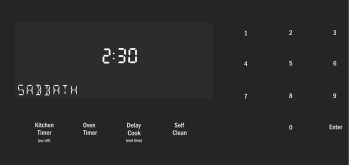
Note:
- The temperature range in Sabbath Mode is 100° F to 450° F.
- The Sabbath Mode timer can be set between 0:01 and 74 hours.
To edit the Sabbath Temperature:
While editing the temperature in Sabbath mode, there is no feedback from the control. If an invalid temperature is set, the oven will default back to the previous running temperature.
- Press the Bake touchpad.
- Enter the new desired set temperature.
- Press Enter.
The oven will adjust its set temperature after a randomized delay
Panel Lock
Allows the user to disable all buttons on the control panel. Panel Lock can only be enabled in stand by mode
- To enable Panel Lock, press and hold the Panel Lock touchpad for 3 seconds (in stand by mode).
- To disable Panel Lock, press and hold the Panel Lock touchpad for 3 seconds. The display returns to stand by mode.
Settings
The oven setup menu is used to customize certain oven settings.
The oven must be in Stand by mode (no cooking mode or timer running) in order to access the setup menu.
To make changes to Settings Menu Items:
- Press the Settings touchpad.
- The first setup item is displayed. The display shows “SET CLOCK”. Press Settings again to access the settings menu.
- To display a different setup item, press the number corresponding to that setting (see following table or press the Settings touchpad to cycle through available options).
- To change the value for the displayed setting press the Enter touchpad to enter the edit mode. Use the numeric keypad to change the setting value. The corresponding setting value is shown in the table following.
For the temperature offset, with the item in edit mode, press “-” or “+” first, then the numeric offset value.
The new value is automatically accepted as the display reverts from edit mode back to display mode.
To exit the Settings menu:
Press the Clear On/Off touchpad.
Oven Temperature Offset
The oven is calibrated to provide accurate results. This feature is useful if you prefer your foods lighter or darker. When an offset temperature is selected, the actual oven temperature is raised or lowered by this value.
The oven must be turned off in order to set an offset value. Refer to “Temperature Offset” in “Settings Menu Options” for setting.
Getting the Most Out of Your Oven
General Tips
Pan Placement
Baking results are better if pans are placed in the center of the oven. If baking more than one pan on a rack, allow at least 1" to 1 ½" of air space around the pan. When baking four cake layers at the same time, stagger pans on two racks so that one pan is not directly above the other.
Rack Position
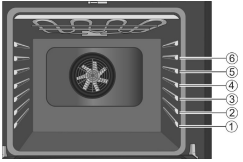
Rack positions are numbered from 1 to 6, from bottom to top. Consult the food cooking charts at the back of this manual for recommended rack positions.
The rail at the top of the oven is used as the guide for the top rack (position 6). Use rack positions 1 through 6 only. DO NOT attempt to use the top guide to support an oven rack.
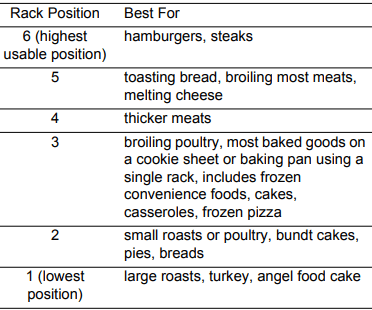
Aluminum Foil
Do not use aluminum foil or protective liners to line any part of the appliance, especially the oven bottom. Installing these liners may result in risk of electric shock or fire.
Preheating the Oven
- Place oven racks in desired position before heating the oven.
- Preheat the oven when using the Bake, Convection Bake, Convection Multi Rack, Pizza, Broil, Convection Broil, and Warm modes.
- Preheat is not used for Roast, Convection Roast and Proof modes.
- Allow oven to preheat while preparing recipe ingredients or food items.
- Setting a higher temperature does not shorten preheat time.
- Once oven is preheated, place food in the oven as quickly as possible to minimize the loss of heat and reduction of oven temperature.
- Use Fast Preheat to speed up preheating time.
Preheat Reminders
Your oven has one of the fastest preheat times in the market using a concealed bake element. The lower element is hidden under the oven bottom. It is normal that the preheat time is different than your previous oven that had an exposed element on the bottom.
- Cleaning the oven is easier because there is no cleaning around a coil element showing on the bottom of the oven. The hidden lower element is protected from food soils and spills. Wiping up excess spills is easy.
- Preheating is not necessary for meats, poultry, casseroles and some frozen foods.
- Preheat time will be longer when the electrical supply to your house is less than 240 volts.
- Increasing the oven temperature will require a longer preheat time. For example, the preheat time for 425° F is longer than the preheat time for 350° F.
When broiling, preheat the oven 3-4 minutes. Do not preheat for more than 5 minutes.
For Best Results
- Use the cooking recommendations as a guide.
- Open the door as briefly as possible to avoid temperature reduction.
- Use the interior oven light to view the food through the oven window rather than opening the door frequently.
- Use the KitchenTimer to keep track of cooking times.
Baking Pans and Dishes
- Glass baking dishes absorb heat. Reduce oven temperature 25° F when baking using glass dishes.
- Preheat the oven before adding glass baking dishes.
- Use pans that provide the desired browning. For tender, light, golden-brown crusts, use light, anodized or shiny metal bakeware.
- Dark, rough or dull pans (nonstick or anodized) will absorb heat and result in a browner, crisper crust. Some manufacturers recommend reducing the temperature 25 ºF when using this type of pan. Follow manufacturers' recommendations.
- Insulated cookie sheets or bakeware will increase the length of cooking time.
- Do not set any heavy object on the open oven door.
- Do not keep empty pans or pizza stones in the oven during cooking as this could change the cooking performance. Store pans outside the oven.
Opening the Oven Door
- Open and close the appliance door only by holding the door handle. To avoid risk of burns, do not touch any other parts of the door.
High Altitude Baking
- When cooking at high altitudes, recipes and cooking times will vary.
- For accurate information, write the Extension Service, Colorado State University, Fort Collins, Colorado 80521. There may be a cost for the guides. Specify which high altitude food preparation guide you prefer: general information, cakes, cookies, breads, etc.
Condensation
It is normal for a certain amount of moisture to evaporate from the food during any cooking process. The amount depends on the moisture content of the food. The moisture may condense on any surface cooler than the inside of the oven, such as the control panel.
Temperature Range by Cooking Mode
Temperatures shown are in Fahrenheit.

Cooking Modes
Bake

Bake is cooking with dry, heated air. Both the upper and lower elements cycle to maintain the oven temperature.
The Bake mode can be used to prepare a variety of food items, from pastries to casseroles. Refer to recipe or package directions for oven temperature and baking time.
Tips
- When using the Bake mode, preheat the oven if the recipe recommends it.
- Baking time will vary with the size, shape and finish of the bakeware. Dark metal pans or nonstick coatings will cook faster with darker results. Insulated bakeware will lengthen the cook time for most foods.
- For best results, bake food on a single rack with at least 1 1/2” space between pans or dishes and oven walls.
- Eliminate heat loss from the oven by using the window to periodically check food for doneness instead of opening the door.
Convection Bake

Convection Bake is similar to Bake. Heat comes from the upper and lower heating elements. The main difference in convection baking is that the heat is circulated throughout the oven by the convection fan.
The Convection Bake mode is well suited for cakes, bar cookies and breads to take advantage of the bottom heat, yielding a better crust on baked items.
The benefits of Convection Bake include:
- Slight decrease in cook time.
- Higher volume (yeast items rise higher).
Tips
- Place food in shallow, uncovered pans such as cookie sheet without sides.
- For cakes use rack positions 2 and 5.
- If baking more than one pan on a rack, allow at least 1” to 1 1/2” of air space around the pan. Stagger pans so that one is not directly above the other (see in next column). Use these rack positions.

Auto Convection Conversion
Convection Bake and Convection Multi-Rack modes require a 25° F reduction in temperature. Auto Convection Conversion reduces the temperature you enter automatically. Simply enter the package or recipe temperature when setting the mode. The control calculates the correct temperature and it is shown in the display.
The Auto Convection Conversion feature can be turned on to allow for automatic temperature adjustments. See “Auto Convection Conversion” in the “Settings Menu Options” on page 20 for details.
Convection Multi-Rack

Multi-Rack mode cooks with heat from a third element behind the back wall of the oven. The heat is circulated throughout the oven by the convection fan.
The Convection Multi-rack mode is well suited for cooking individual serving-sized foods such as cookies and biscuits. It is also good for cooking on multiple racks (2 or 3) at the same time. Baking cookies is possible on 6 racks simultaneously. In this case, the baking time increases slightly.
The benefits of Multi-Rack include:
- Even browning.
- Time savings as a result of using multiple racks at one time.
Tips
- Reduce recipe temperature by 25° F if Auto Convection Conversion is not activated.
- Place food in low-sided, uncovered pans such as cookie sheets without sides.
- If baking more than one pan on a rack, allow at least 1” to 1 1/2” of air space around the pan. Stagger pans so that one is not directly above the other.
Pizza

In the Pizza mode, heat from the upper and lower elements is circulated throughout the oven by the convection fan.
Use the Pizza mode for fresh or frozen pizza.
Tips
- There might be a slight decrease in baking time. Check before minimum package time.
- When baking a frozen pizza: For a crispy crust, place pizza directly on the rack. For a softer crust, use a pizza pan.
- When proofing pizza dough, coat dough with olive oil and cover it in a bowl tightly with plastic wrap to prevent crust formation.
- Sprinkle cornmeal on the pizza pan to prevent sticking.
- If using a pizza paddle, sprinkle the paddle liberally with cornmeal for ease in transferring the dough to the pan.
- If par baking handmade pizza dough, prick the dough with a fork before baking.
- If using a pizza pan, choose a dark, perforated pan for a more crisp crust and a non-perforated pan for a softer crust.
- Preheat baking stones following manufacturer’s recommendations while the oven is preheating.
- Bake homemade pizzas on rack position 2 in the center of the rack.
- Follow manufacturer’s directions for frozen pizza.
- The convection fan cycles on and off when using pizza mode.
Roast

Roast uses both the upper and lower elements to maintain the oven temperature. Roasting uses more intense heat from the upper element than the lower element. This results in more browning of the exterior while the inside remains especially moist.
Roast is best suited for meat and poultry and less tender cuts of meat.
Tips:
- Preheating the oven is not necessary.
- Use a high-sided broil pan or roasting pan. Cover dish with a lid or foil for less tender cuts of meat.
- For less tender cuts of meat, add liquids such as water, juice, wine, bouillon or stock for flavor and moisture.
- Roasting bags and using a lid are suitable for use in this mode.
- When roasting whole chicken or turkey, tuck wings behind back and loosely tie legs with kitchen string.
Convection Roast

Convection Roast uses heat from the top and bottom elements as well as heat circulated by the convection fan.
The Convection Roast mode is well suited for preparing tender cuts of meat and poultry. It is also suitable for roasting vegetables.
The benefits of Convection Roast include:
- As much as 25% faster cooking than non-convection modes.
- Rich, golden browning.
Tips:
- Preheating the oven is not necessary.
- Use the same temperature as indicated in the recipe.
- Check doneness early, since roasting time may decrease. Refer to the Meat/Poultry cooking chart for examples.
- Do not cover meat or use cooking bags.
- Use a broil pan with a rack and grid or a shallow, uncovered pan with a rack for roasting.
- Use a meat thermometer to determine the internal termperature of the meat.
- If the meat is browned to your liking, but is not yet done, a small strip of foil can be placed over the meat to prevent overbrowning.
- Let meat stand covered with foil for 10 to 15 minutes after removing it from the oven.
- Refer to the Meat/Poultry Cooking Chart for recommended rack positions.
Broil

Broil uses intense heat radiated from the upper element.
The Broil mode is best suited for cooking thin, tender cuts of meat (1" or less), poultry and fish. It can also be used to brown breads and casseroles. Always broil with the door closed. The benefits of broiling include:
- Fast and efficient cooking.
- Cooking without the addition of fats or liquids.
Tips:
- Preheat oven 3–4 minutes. Do not preheat for more than 5 minutes.
- Steaks and chops should be at least ¾" thick.
- Brush fish and poultry with butter or oil to prevent sticking.
- Use a broil pan and grid, or a deep pan with a metal rack, for broiling.
- Do not cover the broil grid with foil. It is designed to drain fats and oils away from the cooking surface to prevent smoking and spattering.
- Turn meats (other than fish) once during the recommended cook time. Fish does not need to be turned.
- When top browning casseroles, use only metal or glass ceramic dishes such as CorningWare ®.
- Never use heat-proof glass (Pyrex ®); it cannot tolerate the high temperature.
- For broil times, refer to the Meat/Poultry Cooking Chart.
Convection Broil

Convection Broil is similar to Broil. It combines intense heat from the upper element with heat circulated by a convection fan.
The Convection Broil mode is well suited for cooking thick, tender cuts of meat, poultry and fish. Convection Broil is not recommended for browning breads, casseroles and other foods. Always use convection broil with the door closed.
In addition to the benefits of standard broiling, convection broiling is faster.
Tips:
- Preheat oven 3–4 minutes. Do not preheat for more than 5 minutes.
- Steaks and chops should be at least 1 1/2" thick.
- Use a broil pan and grid, or a deep pan with a metal rack, for broiling.
- Do not cover the broil grid with foil. It is designed to drain fats and oils away from the cooking surface to prevent smoking and spattering.
- Turn meats (other than fish) once during the recommended cook time. Fish does not need to be turned.
- Never use heat-proof glass (Pyrex ®); it cannot tolerate the high temperature.
- For Convection Broil times, refer to the Meat/Poultry Cooking Chart.
Proof

In Proof, the oven uses the lower element to maintain a low temperature to proof bread or other yeast doughs.
- No preheat is necessary.
- Proofing is the rising of yeast dough.
- The Proof Dough mode temperature range is 85° F to 125° F.
- The default temperature in the Proof Dough mode is 100° F.
- Loosely cover the bowl or pan and use any rack that accommodates the size of the container.
- Keep the oven door closed and use the oven light to check the rising of the dough.
Warm

In Warm, the upper and lower elements maintain a low temperature in the oven cavity in order to keep food at serving temperature.
- Use the Warm mode to keep cooked foods hot until ready to serve for up to one hour.
- Warm mode temperatures are 150° F to 225° F.
- The default temperature in the Warm mode is 170° F.
- Foods that must be kept moist should be covered with a lid or aluminum foil.
CAUTION
- When using Warm mode, follow these guidelines:
- Do not use the Warm mode to heat cold food.
- Be sure to maintain proper food temperature. The USDA recommends holding hot food at 140° F or warmer.
- DO NOT warm food longer than one hour.
Cleaning and Maintenance
Cleaning the Oven
Self Clean
During self-clean, the oven is heated to a very high temperature. Soil is burned off at this temperature.
NOTICE: Wipe out excessive spillage before self-cleaning the oven.
NOTICE: Do not clean parts or accessories in the Self-Clean oven. Remove all baking dishes and oven racks from the oven prior to running Self-Clean.
To set the self-clean mode:
1. Remove all accessories and racks from the oven.
2. If there is a cooking mode on, press Oven Clear/Off to end the running mode.
3. Press the Self Clean touchpad below the display.
The self-clean icon  appears in the display. The selfclean timer default (4:00) hours blinks to indicate it can be accepted or changed.
appears in the display. The selfclean timer default (4:00) hours blinks to indicate it can be accepted or changed.
To accept the 4:00 hour default self-clean time, press Enter on the numeric keypad.
To enter a different number of hours use the numeric keypad. The value entered must be within the range of 2:00 to 4:00 hours. Entering a value less than 2:00 or greater than 4:00 results in an error tone and message. Use a longer setting for a heavily soiled oven.
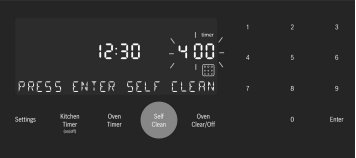
4. When the desired self-clean time is displayed, press Enter on the numeric keypad.
The oven door locks prior to starting Self Clean.
The door lock symbol  is displayed and blinks while the door is being locked. Once locked, the door lock symbol is continuously illuminated (not blinking).
is displayed and blinks while the door is being locked. Once locked, the door lock symbol is continuously illuminated (not blinking).
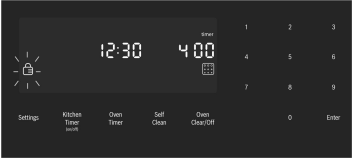
The door lock symbol remains illuminated as long as the self-clean mode is running.
Note: The door remains locked until the oven has cooled down after self-cleaning. The door can be opened again only after “Self Clean” disappears from the display.
5. Self Clean starts and the oven self-clean timer begins its countdown.
To Cancel Self Clean
Press the Oven Clear/Off touchpad to cancel SelfClean.
When the self-clean timer ends, for safety the unit must cool down before the door can unlock. During this period the message “COOLING DOWN” is displayed.
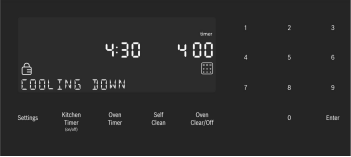
6. When the cool down is complete, the message “SELF CLEAN FINISHED” is displayed. Continue to use caution when opening the oven door.
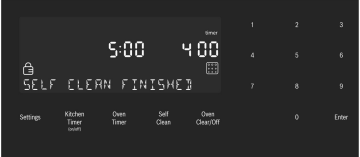
7. Press Oven Clear/Off to clear the display when selfclean is finished.
8. After the oven has cooled down and the door is unlocked, wipe remaining ash from the oven using a moist cloth.
Note:
- The oven light cannot be turned on during selfcleaning.
- The special heat-resistant enamel and the polished components in the oven can become discolored over time. This is normal and does not affect operation. Do not use scouring pads or abrasive cleaners to treat discolorations.
Avoid These Cleaners
Do not use commercial oven cleaners such as Easy Off®. They may damage the oven finish or parts.
Chlorine or chlorine compounds in some cleansers are corrosive to stainless steel. Check ingredients on label.
Never use scouring pads or abrasive cleaners.
Self Help
Cooktop Troubleshooting
Use these suggestions before calling for service to avoid service charges.
| Cooktop Problem | Possible Causes and Suggested Solutions |
| Burner(s) do not light / Ignitors do not spark | • Make sure that the gas shut off valve is in the ON position and the gas supply to the house is not shut off. • Make sure the burner caps are properly positioned and the burner ports are not clogged. Clear ports with a wire or straightened paper clip if clogged. • Make sure the igniters are clean and dry. • Check the power supply. It should be properly grounded with the correct polarity. Make sure the unit is plugged in and the circuit breaker is not tripped. |
| Burner flame goes out unexpectedly | • Make sure that there is no draft in the room. |
| Ignitors spark even though knobs are in the off position | • When the electrical power connection has been activated at the first power up or reconnected after an outage, the igniters may spark once or twice even though all burner knobs are in the off position. |
| Cooking results are not what was expected | • The cooktop is not level. • Cooking pan does not fit the surface being used. • Cookware is not the type or size recommended. |
| Water takes too long to boil | Time to boil can vary greatly depending on environmental conditions. See “Boiling Water” in this manual for tips to decrease time to boil. |
Oven Troubleshooting
Use these suggestions before calling for service to avoid service charges.
| Oven Problem | Possible Causes and Suggested Solutions |
| The oven mode or temperature selected or the numbers selected do not appear in the display | Review manual instructions when setting clock, timer, or Self-Clean. |
| Oven door is locked and will not release, even after cooling | Turn the oven off at the circuit breaker and wait 5 minutes. Turn breaker back on. The oven should reset itself and will be operable. |
| Oven is not heating | Check circuit breaker or fuse box to your house. Make sure there is proper electrical power to the oven. Be sure oven temperature has been selected. |
| Oven is not cooking evenly | Adjust oven calibration if necessary (see “Oven Temperature Offset” on page 19). Refer to cooking charts for recommended rack position. |
| Baking results are not as expected | Refer to cooking charts for recommended rack position. Check “Getting the Most Out of Your Oven” on page 23 for tips and suggestions. Adjust oven calibration if necessary (see “Oven Temperature Offset” on page 19). |
| Food takes longer to cook than expected | The oven is carefully calibrated to provide accurate results. However, the temperature can be offset if food is consistently too brown or too light. See “Oven Temperature Offset” on page 19. |
| Food is overcooked | The oven is carefully calibrated to provide accurate results. However, the temperature can be offset if food is consistently too brown or too light. See “Oven Temperature Offset” on page 19. |
| Convection Bake or Convection MulitRack results are not as Expected | If the Automatic Convection Conversion Feature is turned off, the temperature must be manually reduced by 25°F. If the feature is active, the temperature is automatically adjusted. See “Turn Automatic Convection Conversion ON or OFF” for more information. Refer to cooking charts and tips for rack positions, cooking times and pan selection. Adjust oven calibration if necessary. See “Oven Temperature Offset” on page 19. |
| Oven temperature is too hot or too cold | The oven thermostat needs adjustment. See “Oven Temperature Offset” on page 19. |
| Oven light is not working properly | Replace or reinsert the light bulb if loose or defective. Touching the bulb with fingers may cause the bulb to burn out. |
| Oven light will not turn off | Check for obstruction in oven door. Check to see if hinge is bent. When the Sabbath feature is activated, the oven light will stay on or off (as selected during set-up) during the entire Sabbath mode. |
| Cannot remove lens cover on light | There may be soil build-up around the lens cover. Wipe lens cover area with a clean dry towel prior to attempting to remove the lens cover. |
| Oven will not Self-Clean properly | Allow the oven to cool before running Self-Clean. Always wipe out loose soils or heavy spillovers before running Self-Clean. If oven is badly soiled, set oven for a five-hour Self-Clean. See Preparing the Oven to Self-Clean. |
| Clock and timer are not working properly | Make sure there is electrical power to oven. See Clock and Timer sections. |
| Porcelain chips | When oven racks are removed and replaced, always tilt racks upward and do not force them to avoid chipping the porcelain. |
| “F” and a number appears in display and control beeps | This is a fault code. Press Off to clear the display and stop beeping. Reset oven if necessary. If fault code remains and beep continues, record fault code, cancel oven and call authorized service technician. |
| With a new range there is a strong odor when oven is turned on | This is normal with a new range and will disappear after a few uses. Operating the self-clean cycle will also “burn-off” the smell more quickly. |
| Control does not react when the pad is touched | Be sure that pad is clean. Touch the center of the touchpad. Use the flat part of your finger. |
| Fan is running during modes that don’t use convection | On some models, the convection fan will run while the oven is preheating for the bake mode. This is normal. Slide-in models also have a cooling fan that runs during every cooking mode. |
| Warm air or steam escapes from oven vent | It is normal to see or feel steam or warm air escaping from the oven vent. Do not block the vent. |
| Cooling fan runs after oven is turned off (Slide-in ranges only) | This is normal. When the oven has cooled to a pre-determined temperature, the cooling fan turns off. |
| The cooktop does not operate during SelfClean | This is normal for some models. Operation will return once Self-Clean is complete. |
See other models: SHX88PW55N SHX3AR75UC HCB56651UC SHE863WF6N SPX68U55UC
